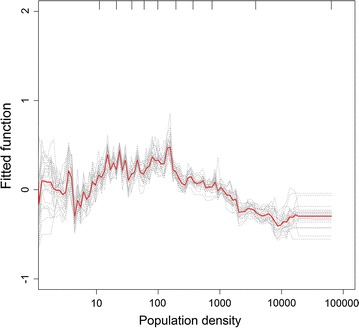Fig. 2.

Partial dependence plot showing the relationship between population density and malaria positivity. Effect after accounting for the average effect of other explanatory variables in Model V Increase in population density was associated with increasing malaria risk until a density of about 100 persons per km2, but a significant decrease is observed for population densities greater than 1000 persons per km2. Population density was transformed on the logarithmic scale due to its skewed distribution in the data. Y axis is on the logit scale and is centred to have zero mean over the data distribution. Dashes at inside top of plots show the data distribution of predictor variables in deciles. Results for each of the 25 bootstrap runs are shown in black dashed lines while the red line represents the average/mean plot
